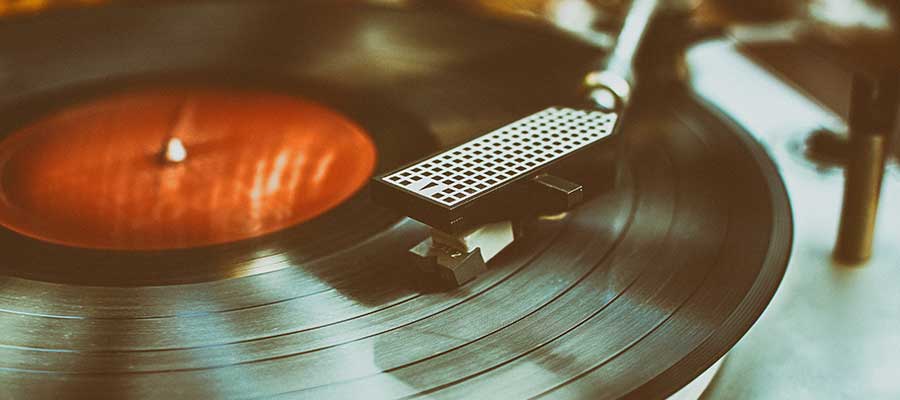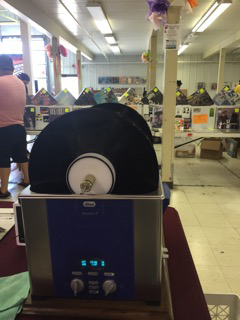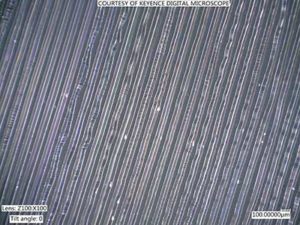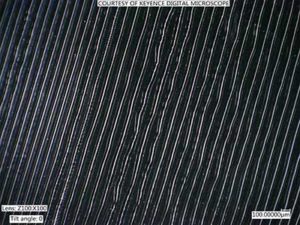
Ultrasonic Cleaning Vinyl Phonograph Records
According to Business Research Insights, the global vinyl records market was valued at $0.36 billion in 2024, and projected to grow to $1.29 billion in 2033. Increasing popularity of “new” vinyl records is matched by collectors looking for “old vinyl.” Depending on a record’s condition, artist, genre, and other factors, “old vinyl” can have values in the thousands of dollars.
Why Ultrasonic Cleaning is Best for Cleaning Old and New Vinyl

Many methods are touted for cleaning old and new vinyl records. But for serious collectors
- Ultrasonic record cleaners are fast
- Ultrasonic record cleaners are gentle
- Ultrasonic record cleaners are thorough
- Ultrasonic record cleaners are safe
That’s why audiophiles as well as professional phonograph record restoration services employ an ultrasonic record cleaner system. It employs an ultrasonic cleaner fitted with a mechanism that slowly rotates the discs into and out of an ultrasonic bath that quickly and safely loosens and strips away the tiniest contaminants from delicate record grooves.
Moreover, the ultrasonic record cleaning system avoids water damage to records’ labels. It is described in the following paragraphs.
How Does an Ultrasonic Record Cleaner Work?
“Ultrasonic” is defined as sound waves above the range of hearing, nominally 20,000 cycles per second, or 20 kilohertz (KHz). Popular ultrasonic cleaner frequencies range from 35 kHz to 45 kHz with exceptions at both ends.
In an ultrasonic record cleaner bath, millions of microscopic vacuum bubbles are created that implode on contact with the record’s surface as it is rotated into and out of the bath – the record cleaning solution.
The higher the ultrasonic frequency the smaller the bubbles and the more capability they have to penetrate fine, high-fidelity record grooves. The process is called ultrasonic cavitation. It quickly and safely loosens and strips away fidelity-degrading dirt missed by brushes or sponges.
More details on this process is found in “How Ultrasonic Cleaners Work”
An Ultrasonic Cleaning System for Vinyl Records

If your records are extremely dirty, lightly vacuum them to remove gross contaminants. This also has the benefit of extending the use of solution used in your ultrasonic record cleaner system.
As to equipment, phonograph record collectors and record restoration professionals use an Elmasonic P series ultrasonic cleaner paired with a record-cleaning accessory that rotates the discs into and out of the ultrasonic cleaning solution.
Following is a description of both components.
The Ultrasonic Record Cleaner
Elmasonic P ultrasonic cleaners are available in 6 solution capacities. These units operate at a user-selected 37 kHz or 80 kHz, and can be programmed to automatically alternate between the two frequencies at 30-second intervals.
The 37 kHz frequency is best for removing heavier grease and dirt deposits on vinyl phonograph records. The higher 80 kHz frequency, with its smaller cavitation bubbles, assures cleaning penetrates the fine grooves in the vinyl – often the lair of scratching, clicks and pops that are so annoying to audiophiles and that can remain after manual record cleaning.
In addition to its dual frequency capability the Elmasonic P series is equipped with a timer, a degas function to quickly remove trapped air from fresh cleaning solutions, and a sweep mode that provides all-important uniform distribution of cleaning action throughout the ultrasonic record cleaner solution.
The control panel shows frequency selection, set and elapsed cleaning time, and selected and actual cleaning solution temperature. kz lower
The Ultrasonic Record-Cleaner Accessory
Ultrasonic record-cleaning accessories for private collectors and professionals offering vinyl record cleaning services are available.
Examples include designs that can be used with the Elmasonic P60H cleaner to clean up to 12 records per batch. They can be equipped with motor/drive units, end caps, lift mechanisms and drying fans, and are designed to slip over the rims of the ultrasonic cleaner.
Setting Up an Ultrasonic Record Cleaning Cycle
Add the cleaning solution to the ultrasonic cleaner tank. While there are several formulations available on the market for this application, a suggestion is adding approximately 2-4 drops of a wetting agent such as liquid dishwashing detergent per gallon of distilled water. This acts as a surfactant to reduce water surface tension and make it “wetter.”

Activate the Degas mode on the ultrasonic cleaner to drive off trapped air.
Cleaning and Drying
Follow the instructions that come with your record cleaner kit.
Cleaning time varies based on the condition and number of records being cleaned. You’ll establish a routine and can use cleaning time to attend to other matters.
At the end of the cycle disassemble the unit, and enjoy the improved sound of your clean classic records!
Maintaining Your Record Cleaning System
To extend the useful life of your ultrasonic record cleaning solution the CleanerVinyl Pro Ultimate option includes a 1-micron particle filtration system that continuously recycles the solution while the unit is in operation. Periodically examining the filter will alert you when it’s time for a replacement.
Otherwise, if you notice a decrease in cleaning efficiency, drain and clean the tank following the instruction manual, then replace and degas your cleaning solution.
Ultrasonic Record Cleaning as a Commercial Enterprise
The resurgence of interest in vinyl recordings has led to service industries specializing in cleaning the discs to preserve their unique sound quality and minimize wear. An example is Pure-Grooves LLC based in the Chicago suburb of Berwin, IL.
Company founder Vince Tornabene has developed a vinyl record restoration service based on the dual-frequency, adjustable power Elmasonic P60H ultrasonic cleaner provided by Tovatech.
According to Mr. Tornabene, regular cleaning results in better sound, preserves investments in discs, extends stylus life and maintains the value of collectables.
“The ultrasonic frequency used depends on the condition of the record with 37 kHz used for extremely dirty discs, Vince says. “This can be followed by the smaller bubbles produced at 80 kHz to complete the cleaning cycle. By removing these contaminants the ultrasonic cleaner lowers surface noise allowing listeners hear music as originally recorded.” And, he adds, helps preserve the stylus.
Extremely dirty discs get a preliminary dunk in a Spin Clean tub then dried. All records are mounted on a motorized spindle that holds up to 4 LPs. Labels are protected by O-rings. The spindle rotates discs into and out of our ultrasonic cleaner bath, a proprietary free rinsing aqueous formulation containing enzymes that handle grease, oil, proteins, starch and sugars.
When records are immersed in the bath cavitation goes to work to safely blast away contaminants; when the discs rotate out of the bath the solution sheets off the surface and drains back into the tank. A typical cycle operates at 2 RPM for 5 to 20 minutes, again depending on the number and condition of the discs.
More on Pure-Grooves’ Selection of the Elmasonic P Ultrasonic Cleaner
“The Elmasonic P series supports the variables that go into our ability to develop perfect record-cleaning cycles based on the condition of the discs,” Mr. Tornabene says. “These include adjustable power, adjustable cleaning solution temperature, adjustable ultrasonic frequency (37 or 80 kHz) and cleaning time.
“It also has a critical Sweep mode that provides a slight variation in ultrasonic frequency that assures more even cleaning while avoiding what are called ‘hot spots’ and ‘dead zones’ of high or no cavitation action.
“These units are of a much higher quality than anything else I’ve tried, and I’ve tried a few, starting with an inexpensive unit from China,” he says. “They don’t have nearly the power advertised, and are poorly designed. You will find that due to the low power, poor transducer placement, standing waves, or other engineering shortcomings that the cleaning result is sub-optimal. This became more evident when more than one record is in the same bath.”
Need More Info on Ultrasonic Record Cleaning?
For more information on selecting and using ultrasonic cleaners for cleaning your records or for any other application, please contact the scientists at Tovatech for unbiased advice.
